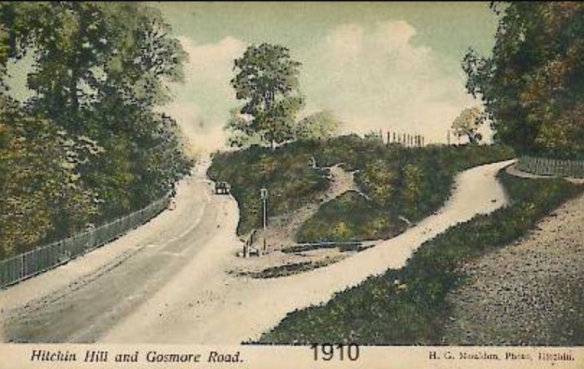If you were to leave the Hertfordshire market town of Hitchin, heading south towards London, a hundred years ago, your journey would have taken you, as it still does today, along a road through a deep cutting with steep tree-lined banks on either side. On its right-hand side, the road followed the border of the parkland belonging to Hitchin Priory, once a Carmelite monastery but by then a prestigious mansion on the edge of town, and now a popular wedding and conference venue. At a certain point, a narrower lane branched off to the right, winding up the steep hill, still running alongside the boundary of Priory Park, before striking out into the countryside towards the ancient hamlet of Gosmore.

It was on Gosmore Road, facing Priory Park, that Gerard Ceunis decided to build his house ‘Salve’, probably at some point in the 1920s. I’ve spent a while trying to identify which of the elegant early twentieth-century villas along this road might have been the Ceunis family home. However, thanks to some help from Tessa Cathcart, the artist’s granddaughter, I’ve now managed to find it. Tessa gave me a number of vital clues. One was her memory of two carved faces, on either side of the oak front door of her grandfather’s house. They are still there. Another was the well-lit attic room that functioned as Gerard Ceunis’ studio: you can still see the window in the photo below. Then there was the fact that the house was compulsorily purchased, some years after her grandparents’ death, when a new relief road was cut through the area. So I knew that the property must have bordered that new development.

‘Oakwood’, formerly ‘Salve’, Gosmore Road, Hitchin (author’s photograph)
Now renamed ‘Oakwood’, the former Ceunis property stands today in a kind of cul-de-sac. Where the road in front of it once ran back down the hill towards Hitchin, it now comes to an abrupt end and has been replaced by a footbridge that crosses Park Way, the busy relief road that was opened in 1981. A new entrance to Gosmore Road has been cut through from the new Three Moorhens roundabout. The garden behind the house is still quite extensive, and the aerial view on Google Maps reveals that there is even space for a swimming pool. But the property is now bordered by a fence and tall bushes screening it from the sight and sound of the main road, whereas Tessa Cathcart tells me that her grandparents’ property once extended across the land now covered by Park Way and by the large roundabout. This map, which overlays the new road layout on a Victorian plan of the area, gives some idea of how things must once have been, and what has been lost (I’ve added a small white dot to represent ‘Salve’):

This aerial view, and the photograph below it, both taken from Google Maps, show even more dramatically how the much-reduced property is now encircled by modern roads:



I wonder how many people, hurtling in their cars along the A602 on their morning or evening commute, realise that they are driving over the former vegetable garden of a Belgian émigré artist? And are the current residents aware that their house was the setting for a crucial scene in a postmodern Basque novel?

An elderly museum visitor told me at the weekend that Salve, as she still called it, was up for sale. I started to look and found that your Ceunis research. has gone ahead in leaps and bounds. Such an interesting local resident. Thanks for all this work.
LikeLike
I’m glad you like the website, Ros. I didn’t know about the house being for sale: I can’t find any information about it online. Good to see the museum open again. Best wishes, Martin.
LikeLike
Hi Martin, I think perhaps she’s not right about a sale. I can’t see anything either.
LikeLike